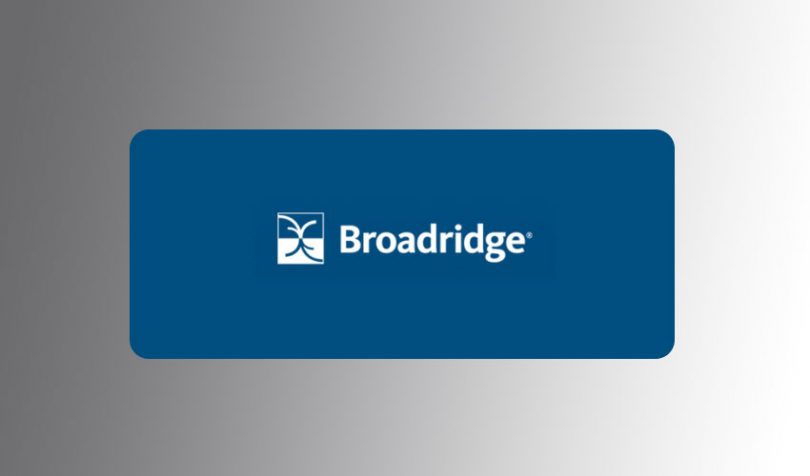NYSE listed Broadridge, best known for its proxy voting solutions, is an investor in blockchain technology company Digital Asset as well as a client. Digital Asset’s technology underpins the Australian Securities Exchange‘s new CHESS settlement system. Following Digital Asset’s open sourcing of its DAML smart contracting language, we asked Broadridge about its thoughts on DAML and, more broadly, enterprise blockchain. Below is an emailed response from Kishore Sheshagiri, Executive VP of Blockchain Strategy at Broadridge.
Highlights
- DAML: enables multidisciplinary collaborative teams working together to solve problems
- DAML: well suited to complex solutions in the DLT world
- DAML: forces developers and business specialists to think differently, necessitating initial learning time
- Enterprise blockchain: explains why some successful pilots are not appropriate for production solutions
- Enterprise blockchain: outlines Broadridge’s criteria in selecting a DLT. At a technology level, the smart contracting language is key
What use cases is DAML particularly useful for, and why?
Broadridge has been exploring multiple DLT solutions over the last four years across various DLT platforms. The financial contracts in capital markets involve complex business logic & multiple party workflows, legal & regulatory compliance needs and inherent need to manage confidentiality & risk.
Most Smart contract technologies either have limitations (or) a high level of implementation complexity and end up not accomplishing the stated promise. DAML in our experience is particularly well suited for building solutions dealing with complex financial contracts including bilateral repos, derivatives and settlement obligations which have complex lifecycles and require active workflow management between multiple parties right from the inception of the contract till its maturity.
DAML brings a high level of sophistication in abstracting the implementation of business rules & workflows from underlying distributed ledger technology, which simplifies and significantly accelerates the time to develop smart contract driven solutions.
How does your team go about selecting a DLT technology for a particular use case?
Broadridge’s primary focus is building permissioned network solutions using the Enterprise DLT platforms. We are agnostic to the underlying execution platform and have built matured pilots and proof of concepts across multiple platforms including Hyperledger Fabric, Quorum, DAML & R3 Corda.
We are noticing that these platforms, while still being distinct, are converging towards solving the top needs of the financial services industry including scalability, privacy, high availability, ease of development and implementation.
Many of the large cloud providers have also started offering “Blockchain as a service” model for these underlying platforms which accelerates adoption.
As we continue to develop our learnings and expertise in these platforms, we are closely working with each of these platforms in sharing our experiences with the larger community as well as adopting the evolving best practices.
We continue to refine and shape our framework in choosing the right DLT technology given a particular business problem. This includes if DLT is the right technology with qualitative feedback from technologists & business SMEs [subject matter experts], the business & operating model factors such as the current market structure, market participants roles and how it is likely to transform in a post-DLT world, the network and its governance model.
These factors are extremely important to consider as it is very likely the chosen DLT platform, while being successful in proof of concept & pilot stage, does not have the enterprise readiness needed to run production-grade solutions.
The technology factors that influence our choice of DLT are primarily around the smart contract development language and its acceptability with clients in a collaborative development model, ease in which the DLT is able to integrate with the existing ecosystem, ability to support privacy and confidentiality, off-chain and on-chain support, infrastructure requirements, scalability and high availability.
You said that “it is very likely the chosen DLT platform while being successful in proof of concept & pilot stage, does not have the enterprise readiness needed to run production-grade solutions.” Can you give examples of the sorts of issues that you’ve encountered?
Enterprises require solutions that are highly secure, scalable, reliable and have high availability. Disaster recovery and business continuity are important considerations. It is also becoming clear that DLT needs to be able to co-exist with existing infrastructure if not interoperable with each other.
There have been significant strides made in the Enterprise DLT space around privacy, confidentiality, improving processing speed and reliability but the underlying technology is still fundamentally complex and instrumentation tools for DLT network monitoring, automated alerts, exploring data in Blockchain, ability to upgrade with minimal impact, etc. are limited (or) don’t meet enterprise standards yet.
Distributed systems are heavily dependent on strong network infrastructure and protocols that are battle-tested and extremely secure. It is important these considerations are evaluated during the pilot & MVP phase for choosing the right DLT for a given business solution.
You mentioned the analysis of “market participants roles and how it is likely to transform in a post-DLT world”. How do you approach this analysis?
Broadridge has a structured methodology looking at the current state of how given business operations work, the market participants involved, their roles and the value they bring today and how the participants are interconnected and the inherent risks that exist in the current ecosystem.
Our analysis includes “understanding the friction that exists in the current state and its impact on the overall cost/risks to the market participants” and if a DLT world would bring significant benefits to the ecosystem including an improved business & operating model, improved risk management, Improved operational and cost efficiency.
It is important to understand that many of the industry ecosystems that exist today have evolved over many years and are working fairly efficiently; in DLT ecosystems we look to eliminate non-value adding functions performed by the various market participants that everyone understands will impact a particular participant’s business negatively in the short term but will result in long term benefits to individual participants as well the larger ecosystem.
Our analysis focuses on the “network effect” that a DLT world could bring and what new revenue opportunities exist for the market participants.
What are specific features or functionality of DAML that you particularly like or dislike?
DAML’s richness in abstracting the business logic from the execution engine helps developers focus on getting the functionality right at an accelerated pace; the modeling language is also helpful in simplifying and codifying the contracts and the associated rights and obligations to a level that helps the business understand the technology implementation far more effectively relative to other technology.
The DAML SDK also has a very powerful feature which allows developers to test the various scenarios in parallel to the development. This is extremely useful in ensuring test driven development methodology, and in context of distributed ledger, this is significant in terms of reducing not just the technical debt but limiting the governance challenges that arise with making large scale changes.
The DA team is also building reusable and extensible reusable DAML libraries which is very helpful in bringing standardization.
What was different (with DAML) compared to expectations: both positive and negative
We have been working in DAML for slightly over a year now, and our experience with DAML has largely been positive. It would not be easy to categorize our experience as positive or negative to our expectations, but it would be wise to say that DAML brings about an interesting paradigm to building distributed ledger solutions.
Most of the DLT solutions focus primarily on ledger level mechanics and are primarily driven by technologists, which results in different stakeholders having different expectations.
DAML enables the multidisciplinary collaborative teams working together to solve problems with a relatively high level of agility. DAML does force developers and business SMEs to think very differently and necessitates a high level of initial learning time and understanding which differs from other DLT platforms.
What was learned that would have been useful to know/understand earlier?
DAML differs from other general programming languages that are being used for smart contracts in other platforms. This requires a special skillset and a general understanding of “functional language” paradigm and appreciation of formal methods which are key to successful design and implementation of DAML driven solutions.
How does DAML compare with other ‘workflowy’ smart contracting languages?
The accuracy of state of the distributed ledger is what brings trust in an untrusted execution environment. The role of smart contracts in achieving this accuracy cannot be understated.
The general purpose programming language used to develop smart contracts in most DLT platforms due to a reliance on the underlying execution engine does not always guarantee accuracy & integrity, and most platforms address this by restricting what the smart contracts could do.
Developers need to focus on building workflows on top of Smart contracts to ensure accuracy of the execution. This is complex in nature and amplified in a distributed environment. DAML’s unique approach marrying the workflows with business logic within the smart contract is well suited for complex solutions in the DLT world.






